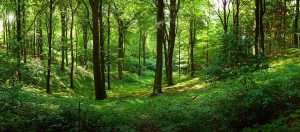

MedFriendly®


Hylophobia
Hylophobia is an abnormal and intense fear of forests.
Hylophobia can develop in response to a prior traumatic
experience with forests, trees, or wood. Examples
include being attacked in a forest, being attacked with a
piece of wood such as a club, or developing a severe
case of poison ivy in the woods.
FEATURED BOOK: The Anxiety and Phobia Workbook
These fears can be exacerbated by thoughts of horror movies in which people get
attacked in the woods (e.g., Friday the 13th, Blair Witch Project) or childhood stories of
people getting lost/abducted in the woods by mean creatures (e.g., the witch in Hansel
and Gretel and the Big Bad Wolf in the classic Little Red Riding Hood). When hylophobia
hylophobia includes extreme anxiety, nausea, vomiting, rapid breathing, shortness of
breath, irregular heartbeat, excess sweating, dry mouth, difficulty speaking, and shaking.
A psychological technique that is very helpful in treating hylophobia is cognitive
behavioral therapy (CBT) in which people learn to change their thoughts to change their
resulting feelings.
The person learns not to over-estimate the risk of being harmed by forests, trees, or
woods by understanding that not all experiences with them are harmful or will lead to
catastrophic health outcomes. In this way, thoughts become less intrusive and anxiety-
provoking.
"Where Medical Information is Easy to Understand"™
CBT is the most common form of treatment. Another technique is a
method known as desensitization in which a person is taught how to
relax when being exposed to progressively more intense forms of
the feared stimuli (e.g. a stick, a branch, a tree stump, a tree, a row
of trees, a forest). The person is exposed to more intense forms of
the stimulus as they master the fear at the less intense level.
Sometimes, the more intense form of the stimuli is based on the
amount of the stimuli whereas in other cases it may be based on the
duration of exposure (e.g., 1 minute, 2 minutes, 3 minutes, etc.,
such as the length of time in the forest). CBT is often combined with
desensitization and typically works within a few months.
A more insight-oriented technique involves exploring the original cause of the phobia (e.g., a traumatic
childhood event) and trying to resolve issues surrounding this. This may involve use of CBT techniques
and/or other counseling methods. An unproven technique for hylophobia is hypnotherapy, in which a
suggestible person is taught sub-consciously to not be so afraid of the feared stimuli. Hylophobia can be
treated by an anti-anxiety medication designed to decrease anxiety. Sometimes, antidepressant
medications may be used because some anti-depressants are useful for treating anxiety as well as
depression. Hylophobia is also known as hylephobia. Hylophobia comes from the Greek word "hyle"
meaning "forest," and the Greek word "phobos" meaning "fear. Put the two words together and you have
"fear (of) forests."















